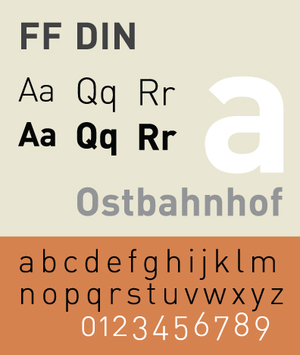
DIN (typeface)
Encyclopedia

Deutsches Institut für Normung
is the German national organization for standardization and is that country's ISO member body. DIN is a Registered German Association headquartered in Berlin...
(German Institute for Standardization), and the name of an increasingly large realist sans-serif typeface family. In 1936 the German Standard Committee selected DIN 1451
DIN 1451
DIN 1451 is a realist sans-serif typeface that is widely used for traffic, administration and business applications. It has been defined by the German standards body Deutsches Institut für Normung since 1936.-Overview:...
as the standard typeface for use in the areas of engineering, technology, traffic, administration and business. Among the other recommendations adopted by this committee was an early precursor to the typographic grid.
The earliest version of a DIN typeface was released by the D Stempel AG foundry in 1923. Stempel's design was based on a 1905 typeface for the Königlich Preußische Eisenbahn-Verwaltung (Royal Prussian Railway Administration) and was applied mostly to schematics and blueprints. This version later became the basis for DIN-Engschrift (Condensed). In 1929, the Berthold foundry released a version, and it, too, was used mostly for technical drawings. Both of the early DIN typefaces were made available as lettering templates cut from an acetate material for drafting use. Both of the earliest DIN typefaces were used primarily in oblique form.
Popularity grew rapidly, once the DIN typeface was adopted. The most widely-used of the DIN-1451 group was DIN-Mittelschrift (Medium). It was released as a metal type, as acetate stencils for smaller applications, as larger metal stencils for application to vehicles and in train yards, and as cast metal lettering for street and building signage. Polish and Cyrillic variants of the face were developed in the 1940s.
Though Bauhaus
Bauhaus
', commonly known simply as Bauhaus, was a school in Germany that combined crafts and the fine arts, and was famous for the approach to design that it publicized and taught. It operated from 1919 to 1933. At that time the German term stood for "School of Building".The Bauhaus school was founded by...
used a DIN-inspired logo in catalogs and in a periodical during the 1930s, DIN did not become popular in print until the 1960s. The transferable-lettering-sheet company, Letraset
Letraset
Letraset is a company based in the Kingsnorth Industrial Estate in Ashford, Kent, UK.It is known mainly for manufacturing sheets of artwork elements which can be transferred to artwork being prepared. The name Letraset was often used to refer generically to sheets of dry transferrable lettering of...
made several variants available in the 1970s. By the late 1980s, use of DIN typefaces were appearing in European and North American graphics work. In 1995, Dutch typeface designer Albert-Jan Pool
Albert-Jan Pool
Albert-Jan Pool is a Dutch professional type designer. He studied at the Royal Academy of Arts in The Hague....
drew a multi-weight version, eventually licensing it to FontShop
FontShop
FontShop was founded in Berlin in 1989 by Erik Spiekermann and Joan Spiekermann, who were then husband and wife, and Neville Brody. FontShop was the first font reseller in digital type history. There are four independent FontShops in Austria, Benelux, Germany, and the USA.FSI FontShop International...
International as FF DIN
FF DIN
FF DIN is a realist sans-serif typeface designed in 1995 by Albert-Jan Pool, based on DIN-Mittelschrift. DIN is an acronym for Deutsches Institut für Normung ....
. The FF DIN family, unlike DIN 1451, uses simplified-standard weight names.

